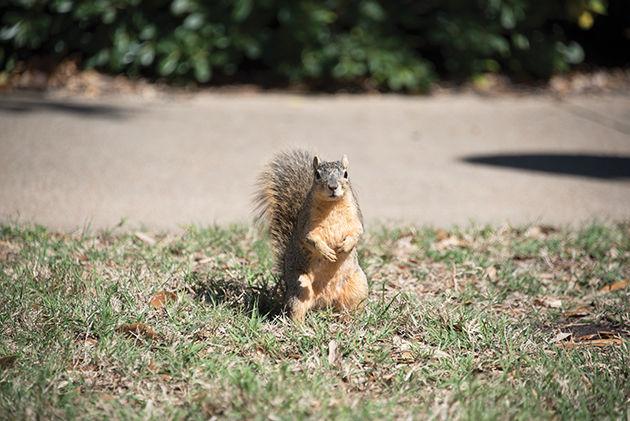Texas A&M’s campus is known mainly for its architecture, academics, athletics and memorials to tradition that all attract attention. One of the less-often acknowledged aspects of A&M’s campus, however, is the wildlife.
A&M is home to several species of animals, ranging from the squirrels seen all around campus to the fish in the Bush Library’s ponds.
“Any species that also occurs in Brazos county could occur on campus,” said Heather Prestridge, curator of the Biodiversity Research of the Department of Wildlife. “Our collections publish specimen data to see which species have been documented on campus.”
Prestridge said there are multiple reasons for animals being attracted to a college campus.
“Wildlife are attracted to places that offer suitable habitat for their lifestyle,” Prestridge said. “In urban environments bats choose to nest in built structures, whereas squirrels create their dreys in trees across campus.”
One of the lesser-known groups of animals on campus are the fish, said Kevin
Conway, associate professor of the Department of Wildlife and Fisheries Sciences.
“There are multiple species of fishes inhabiting the creeks, ponds and lakes scattered around campus,” Conway said. “Potentially as many as 10 different species, though there may be more. White Creek, which has its headwaters on West Campus, is certainly the most pristine water body on campus and likely has more species of fishes than any other water body on campus.”
Most of the fish on campus are here naturally, although some ponds have been stocked, Conway said.
“Most fish present on campus certainly found their way here naturally but some of the larger ponds have been intentionally stocked with fishes over the years,” Conway said. “This includes stocking of Channel Catfish, Largemouth Bass and Bluegill into the pond next to the George Bush Library.”
Conway said the fish play a role in affecting the local ecosystem.
“Of course some of these fish are at the bottom of the food chain and provide a source of food for birds and turtles,” Conway said.
Not all the animals on campus play a positive role in the ecosystem, according to Prestridge.
“The cats you see on campus are not wildlife, they are domesticated cats that have gone feral,” Prestridge said. “They are disruptive to native wildlife and have a negative impact on songbirds in particular. Bobcats, which are native, do occur in the area, but I wouldn’t expect to ever see one on campus.”
With a fishing permit, fishing in the Bush Library pond is allowed, but is limited to catch and release, according to a sign outside the pond.
Other notable documented animals seen on campus include songbirds, turtles, fish, squirrels, feral cats and several species of insects. Students interact with the animals on occasion.
“I like how we have a sustained populations of cats near Heldenfels; they seem to be treated well,” said engineering freshman Tres Duytschaever. “With how well they’re treated, it really shows how welcome as a campus we are.”
Allied health junior Blake Doughtie said he is particularly fond of the squirrels.
“The squirrels are cute, and it brightens my day every time I see one come up to me when I’m on campus,” Doughtie said. “I wish I could catch one, put it in my backpack, and bring it to one of my lectures with me.”
Duytschaever also said he believes the squirrels are too tame.
“I don’t think the squirrels can live anywhere but campus at this point,” Duytschaever said. “They’re just too docile and used to human interaction. I mean you see people feed and pet them all the time. They’re just dependent on us now.”
Duytschaever said he doesn’t believe A&M should do anything to hinder or help the local wildlife.
“I think we’re at a good place with the wildlife,” Duytschaever said. “Bringing in more animals or removing the ones we have would have too much of an effect on the ecosystem, so we should just leave them be.”
Additional information regarding the species of animals on campus can be found in the Department of Wildlife. The Aggie Aquarium Association maintains an aquarium of native fishes in Nagle Hall, and the department has a nationally recognized collection that documents vertebrae in Texas and other states located off campus, which is limited to researchers and students taking classes in the department.
Campus Critters
March 7, 2017
Photo by Photo by Cassie Stricker
Squirrels are among the wildlife found on campus.
0
Donate to The Battalion
$2065
$5000
Contributed
Our Goal
Your donation will support the student journalists of Texas A&M University - College Station. Your contribution will allow us to purchase equipment and cover our annual website hosting costs, in addition to paying freelance staffers for their work, travel costs for coverage and more!
More to Discover










